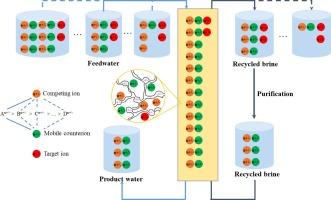当前位置:
X-MOL 学术
›
Sep. Purif. Technol.
›
论文详情
Our official English website, www.x-mol.net, welcomes your
feedback! (Note: you will need to create a separate account there.)
Self-inhibition mechanism of competitive ions for low-cost, highly selective ion removal in a standard ion-exchange resin-packed column process
Separation and Purification Technology ( IF 8.1 ) Pub Date : 2024-11-19 , DOI: 10.1016/j.seppur.2024.130603 Zhixuan Wang, Mengya Guo, Shaokui Zheng, Xiaoying Yang, Xiangnan Zheng
Separation and Purification Technology ( IF 8.1 ) Pub Date : 2024-11-19 , DOI: 10.1016/j.seppur.2024.130603 Zhixuan Wang, Mengya Guo, Shaokui Zheng, Xiaoying Yang, Xiangnan Zheng

|
This study experimentally confirmed the self-inhibition mechanism of competing ions in a commercially available standard ion-exchange resin (IER) column process in order to realize selective removal of target problematic ions from feedwater using eight anions. The removal of SO42− (or HPO42−, I−, BrO3−, as competing ions) from binary feedwater during exhaustion was completely inhibited (<5 % removal) following circular activation of the standard IER column by binary brine with the critical SO42− (or HPO42−, I−, BrO3−) equivalent fraction (EF[brine]) of 0.93 (or 0.93, 0.28, 0.44) (with Cl− as mobile counterion). Negligible changes in the critical SO42− EF(brine) values (92–94 %) or the critical SO42− equivalent fractions in the IER phase (∼70 %) were observed when the SO42− equivalent fractions in the SO42−-Cl− binary feedwater changed substantially (15–65 %). The introduction of MoO42−, NO3−, or HCO3− (as coexisting ion) into the SO42−-Cl− binary feedwater also had a negligible effect on the critical SO42− EF(brine) values (82–84 %). The complete inhibition of SO42− removal from high-salinity SO42−-Cl− binary feedwater (∼10 % salinity) during exhaustion was realized even when low-salinity SO42−-Cl− binary brine (∼1 % salinity) was used. The complete self-inhibition of Cl− or BrO3− having the lowest selectivity sequence during exhaustion was realized even when SO42− having the highest selectivity sequence was used as the mobile counterion. These results provide new knowledge concerning the classic ion-exchange mechanism developed 70 years ago, and will facilitate improved design and operation of the standard IER-based selective ion removal process.
中文翻译:

竞争性离子的自抑制机制,可在标准离子交换树脂填充柱工艺中实现低成本、高选择性的离子去除
本研究通过实验证实了市售标准离子交换树脂 (IER) 塔工艺中竞争离子的自抑制机制,以实现使用 8 个阴离子从给水中选择性去除目标问题离子。在用临界 SO42−(或 HPO 42−、I−、BrO 3−) 等效馏分 (EF[盐水])为 0.93(或 0.93、0.28、0.44)(以 Cl− 作为移动对离子)。当 SO42−-Cl− 二元给水中的关键 SO42− EF(盐水)值 (92-94%) 或临界 SO 4 2− 当量馏分发生重大变化 (15-65%) 时,观察到 IER 阶段临界 SO42− EF(盐水)值 (92-94%) 或临界 SO4 2− 当量馏分 (∼70%) 的变化可以忽略不计。将 MoO42−、NO3− 或 HCO3−(作为共存离子)引入 SO42− Cl− 二元给水中,对临界 SO42− EF(盐水)值 (82-84%) 的影响也可以忽略不计。 即使使用低盐度 SO42−-Cl− 二元盐水(∼1 % 盐度),在枯竭过程中也能完全抑制从高盐度 SO42−-Cl− 二元给水中去除 SO42− 即使使用∼1 % 盐度)。即使使用具有最高选择性序列的 SO42− 作为移动对离子,在耗竭过程中也实现了具有最低选择性序列的 Cl− 或 BrO3− 的完全自抑制。这些结果为70年前开发的经典离子交换机制提供了新的知识,并将有助于改进基于IER的标准选择性离子去除工艺的设计和操作。
更新日期:2024-11-20
中文翻译:

竞争性离子的自抑制机制,可在标准离子交换树脂填充柱工艺中实现低成本、高选择性的离子去除
本研究通过实验证实了市售标准离子交换树脂 (IER) 塔工艺中竞争离子的自抑制机制,以实现使用 8 个阴离子从给水中选择性去除目标问题离子。在用临界 SO42−(或 HPO 42−、I−、BrO 3−) 等效馏分 (EF[盐水])为 0.93(或 0.93、0.28、0.44)(以 Cl− 作为移动对离子)。当 SO42−-Cl− 二元给水中的关键 SO42− EF(盐水)值 (92-94%) 或临界 SO 4 2− 当量馏分发生重大变化 (15-65%) 时,观察到 IER 阶段临界 SO42− EF(盐水)值 (92-94%) 或临界 SO4 2− 当量馏分 (∼70%) 的变化可以忽略不计。将 MoO42−、NO3− 或 HCO3−(作为共存离子)引入 SO42− Cl− 二元给水中,对临界 SO42− EF(盐水)值 (82-84%) 的影响也可以忽略不计。 即使使用低盐度 SO42−-Cl− 二元盐水(∼1 % 盐度),在枯竭过程中也能完全抑制从高盐度 SO42−-Cl− 二元给水中去除 SO42− 即使使用∼1 % 盐度)。即使使用具有最高选择性序列的 SO42− 作为移动对离子,在耗竭过程中也实现了具有最低选择性序列的 Cl− 或 BrO3− 的完全自抑制。这些结果为70年前开发的经典离子交换机制提供了新的知识,并将有助于改进基于IER的标准选择性离子去除工艺的设计和操作。


















































 京公网安备 11010802027423号
京公网安备 11010802027423号